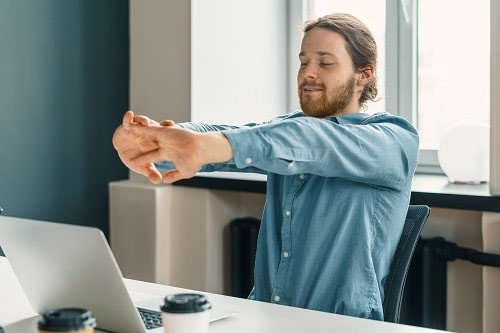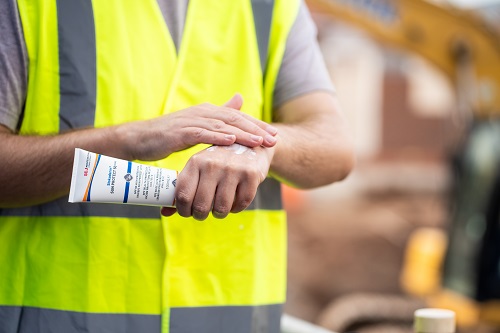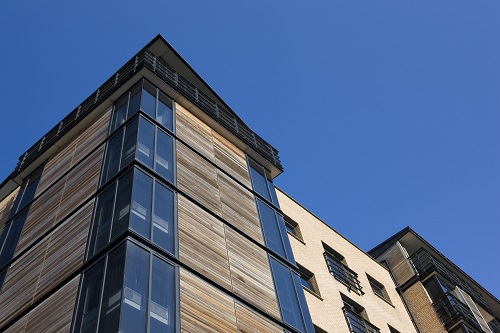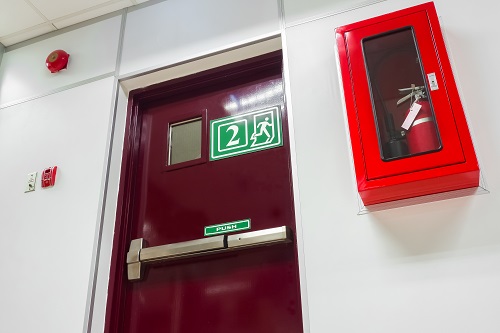Exploring how employers can help manage musculoskeletal pain caused by sedentary desk working.
Features
Danger at the desk
Manual work may be the biggest cause of self-reported musculoskeletal problems, but newer thinking says we must look at the desk as well. In particular, we must challenge the view that repetitive or strenuous work has to be active in nature.
And while prevention is the first tool, little is said about how we support people once they’ve developed a condition or how to help them recover from one. So, what do employers need to know and what advice is out there?
The headlines
First, let’s look at the scale of the issue. Nearly half a million, or 470,000 workers, suffered from new or long-standing work-related musculoskeletal disorders (MSDs) in 2020/21 with the neck, arm, shoulder and back accounting for most issues reported via Labour Force Survey data. According to HSE, 8.9 million days were lost in 2019/20 due to MSDs. Behind mental health, they are the second most common cause of ill health at work.
 The reality is most of us will develop body pains through working, and we need to act on them before they get worse. Photograph: iStock
The reality is most of us will develop body pains through working, and we need to act on them before they get worse. Photograph: iStock
Yet, these common and completely preventable conditions are not talked about seriously, says Professor Stephen Bevan who heads up HR research development at the Institute for Employment Studies.
Bevan was recently struck by an interesting parallel in the June rail strikes. “Newspapers were running headlines about the economic impact, but strike action translates to something like 300,000 days lost each year, which is tiny by comparison to days lost to MSDs. No one really focuses too on chronic low back pain or neck or shoulder problems, but it’s having a much more consistent and long-standing impact on labour productivity in the UK.”
There are more than 200 types of musculoskeletal disorders, which affect 1 in 4 of the adult population according to NHS England. They can be episodic, relatively short-term conditions that get better or they can be chronic, defined as persistent pain that has lasted more than three months.
There are also progressive conditions like rheumatoid arthritis and other diseases of the musculoskeletal system that have a significant impact on people’s ability to work. Regardless, for all of us, musculoskeletal health is not just important for our ability to function today, it is also fundamental to healthy ageing.
First steps to support
Key to providing the right support is to identify the problem in the first place. This can be easier said than done, according to Phil Pinnington, audit and consultancy manager at the British Safety Council: “It’s very difficult to say which is the one cause; is it your chair with no back support? Or is the lighting poor, are you stressed? It could be a combination of those things.”
He adds that home life can make attribution difficult: “Your workstation is only one part of your 24-hour cycle. Is your back problem a work-related problem or is it because you spend seven hours of an evening on a PlayStation sitting? That’s going to have the same impact.”
 Physios are now able to can issue a ‘fit note’, which says a person can come back to work providing the employer makes specified adjustments. Photograph: iStock
Physios are now able to can issue a ‘fit note’, which says a person can come back to work providing the employer makes specified adjustments. Photograph: iStock
Nevertheless, even if our sedentary and screen-related tasks may not be the sole cause of the issue, they can be a big contributing factor, says Simon Redstone, who runs two physiotherapy practices in London. He says: “I would say at least 70 per cent or more of my clients come with pains that have been caused or made worse by working at the desk.” He adds that many injuries are multi-factorial: “It is hard to pinpoint how much are due to the desk.”
Necks and backs
His clinics’ most common cases are lower back and necks followed by knees and shoulders. He saw ‘a lot’ of neck pain during the first lockdown particularly, when many of us were hunched over laptops: “When you bend your head forward 15 degrees, the weight the neck must carry doubles and another 15 degrees, it doubles again. This has been termed tech neck – phones as well as laptops.”
Indeed, in IES research, 58 per cent of people surveyed said they had ‘rather or much more’ neck pain two weeks into the lockdown, with a third still experiencing the same pain over two months later. Comparable results were reported for backs, shoulders, wrists and hips.
Sustained sitting positions and stress can also impact on our backs. Redstone explains that our back discs are like cushions between the vertebrae. Sitting has the effect of squashing down on them, affecting the lower lumbar spine: “A lot of people associate disc issues with lifting weights off the floor and suddenly feeling pain in the back. But a lot of what we treat as an underlying cause tend to be disc originated pain, which is accumulation of load over time.”
 Regular breaks to stretch help to prevent as well as manage musculoskeletal pain. Photograph: iStock
Regular breaks to stretch help to prevent as well as manage musculoskeletal pain. Photograph: iStock
He caveats that “discs are ok to be loaded”, but it’s about shifting where that load is put over the working day. “This means moving from a seated to a standing position intermittently.” Hourly breaks to stretch or move is a good guide and he’s a big fan of standing desks.
Like back injuries, repetitive work is something we normally associate with some types of manual labour. But at the desk we also hold and repeat positions – typing, moving a mouse, craning at a screen – that our bodies were not intended to do. “We are designed to move – it’s about that rather than getting caught up in having a perfect desk set up,” says Redstone.
Adjustments
So, what should employers do to help their workers recover from a desk-based injury? “One, identify the issue. Two, make reasonable adjustments,” summarises Pinnington. “If it’s a recognised condition like RSI, you can provide ergonomic keyboards and mice for next to nothing. The equipment and technology is out there and it’s not necessarily expensive. If a person has more complex MSD issues you can get an ergonomist in to do a workstation assessment. Every employer should do a self-assessment.”
Bevan adds that it’s about ‘an attitude of flexibility’ as much as making material changes: “Even if it’s flexible start and finish times or giving people more regular breaks or time off for medical appointments, it’s really not difficult.”
The employer should take the lead from the GP, physio, or other health professional. They can issue a ‘fit note’, which says a person can come back to work providing the employer makes specified adjustments. But also, Bevan says, employees themselves are experts in what support they need.
Having come through serious cancer treatment, he explains how valuable it was to have a role and a say in his adjustments on returning to work: “I was very conscious of my need to get back to contributing and doing my job as best as I could. But the thing I found really empowering was being able to play an active part in managing my return to work and which adjustments would work best for me.”
Individual support
Is the advice and guidance for screen-based workers up to scratch? Some say not. “A lot of employers are confused about where there’s a legal obligation, where there isn’t,” says Bevan. Indeed, Acas says that an employer “must consider making reasonable adjustments when they know an employee or job applicant has a disability.” But most MSDs won’t be classified as such (and we don’t want them get to that stage before we help!). “If you have someone who has a functional capacity problem, there’s a business case for providing adjustments. And I think there’s a moral obligation too,” says Bevan.
 Making adjustments can be as simple as supporting people to take time out of their day to attend medical appointments. Photograph: iStock
Making adjustments can be as simple as supporting people to take time out of their day to attend medical appointments. Photograph: iStock
Others say the key to treating these issues is to share advice and encourage people to make their own changes. “It’s about raising the profile and educating people,” says Pinnington. “In the past, you’d go to the boss and say you had a back problem. They’d get in occ health and sort out a chair. Done. But that doesn’t solve the problem.”
We need education on healthy behaviours. According to Dr Barbara Bergin, an orthopaedic surgeon from the US, hip pain is more common in women than men and that’s because they tend to cross their legs, or lean on one leg when sitting. She says women should ‘sit like a man’ to avoid pains building up: “Keep those knees pointed at 11:00 and 1:00. And keep your feet flat on the ground.”
She refers to it on a daily basis for her female patients suffering from conditions including greater trochanteric bursitis (hip pain caused by inflammation at the lateral point of the hip). “It’s a women’s’ health movement. And I’m starting it!”
Embarrassment and fear of disclosing issues
It’s important to note that we have a huge barrier when it comes to disclosing problems – it’s true of mental ill health issues and it’s often true of our back and body pains.
In the IES lockdown study on home workers, they found there was a correlation between having musculoskeletal pain and poor sleep and fatigue and then those things impacting on mental health. “A lot of people are concerned about disclosing they have a condition and that says something about the sort of wider workplace culture that we need to try and address, particularly if it’s a mental health related issue as well,” says Bevan.
More needs to be done to stop pain in our precious arms, backs and shoulders building up through preventative work around education. But we also need to educate workers how some of these basic tips – around movement and frequent breaks for eyes and body – can also help manage symptoms and speed recovery. “Pain shouldn’t take years to resolve. It’s about managing the symptoms through movement alongside strengthening work,” says Redstone. Pain can change, so why not invest in solving it?
The reality is many of us will develop body pains through our work, and we need to act on them before they get worse. As Bevan says: “The idea that you can be in a job where you’re working intensively at a keyboard and screen for long periods of time without any breaks, I think really risks causing or exacerbating MSDs. Employers shouldn’t underestimate that.”
HSE's statistics for work-related musculoskeletal disorders in Great Britain here
FEATURES

Facing the facts: protecting your outdoor workforce from UV exposure and skin cancer
By SC Johnson Professional on 11 July 2025
With outdoor workers at significant risk of skin damage, ageing and cancer due to exposure to the sun’s UV rays, it’s essential that employers in sectors like construction and agriculture create a working environment where sun safety precautions become the norm, rather than the exception.

2025 UK fire safety regulation updates: a quick guide
By Chloe Miller on 11 July 2025
The regulatory landscape covering fire safety arrangements and structural features in domestic and commercial buildings has undergone a number of significant changes in recent years, making it essential for responsible persons to review their approach to keeping residents, workers and the nearby public safe from the risk of fire.

Tackling new fire risks as Fire Door Safety Week celebrates 12th year
By Helen Hewitt, British Woodworking Federation on 11 July 2025
The British Woodworking Federation’s annual Fire Door Safety Week this September will encourage duty holders such as those in charge of residential buildings to consider the dangers from lithium-ion batteries and ensure fire doors remain fit for purpose in reducing the risk should a battery-related fire break out.



